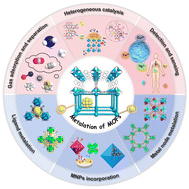Metalation of metal–organic frameworks: fundamentals and applications
Abstract
Metalation of metal–organic frameworks (MOFs) has been developed as a prominent strategy for materials functionalization for pore chemistry modulation and property optimization. By introducing exotic metal ions/complexes/nanoparticles onto/into the parent framework, many metallized MOFs have exhibited significantly improved performance in a wide range of applications. In this review, we focus on the research progress in the metalation of metal–organic frameworks during the last five years, spanning the design principles, synthetic strategies, and potential applications. Based on the crystal engineering principles, a minor change in the MOF composition through metalation would lead to leveraged variation of properties. This review starts from the general strategies established for the incorporation of metal species within MOFs, followed by the design principles to graft the desired functionality while maintaining the porosity of frameworks. Facile metalation has contributed a great number of bespoke materials with excellent performance, and we summarize their applications in gas adsorption and separation, heterogeneous catalysis, detection and sensing, and energy storage and conversion. The underlying mechanisms are also investigated by state-of-the-art techniques and analyzed for gaining insight into the structure–property relationships, which would in turn facilitate the further development of design principles. Finally, the current challenges and opportunities in MOF metalation have been discussed, and the promising future directions for customizing the next-generation advanced materials have been outlined as well.



 Please wait while we load your content...
Please wait while we load your content...